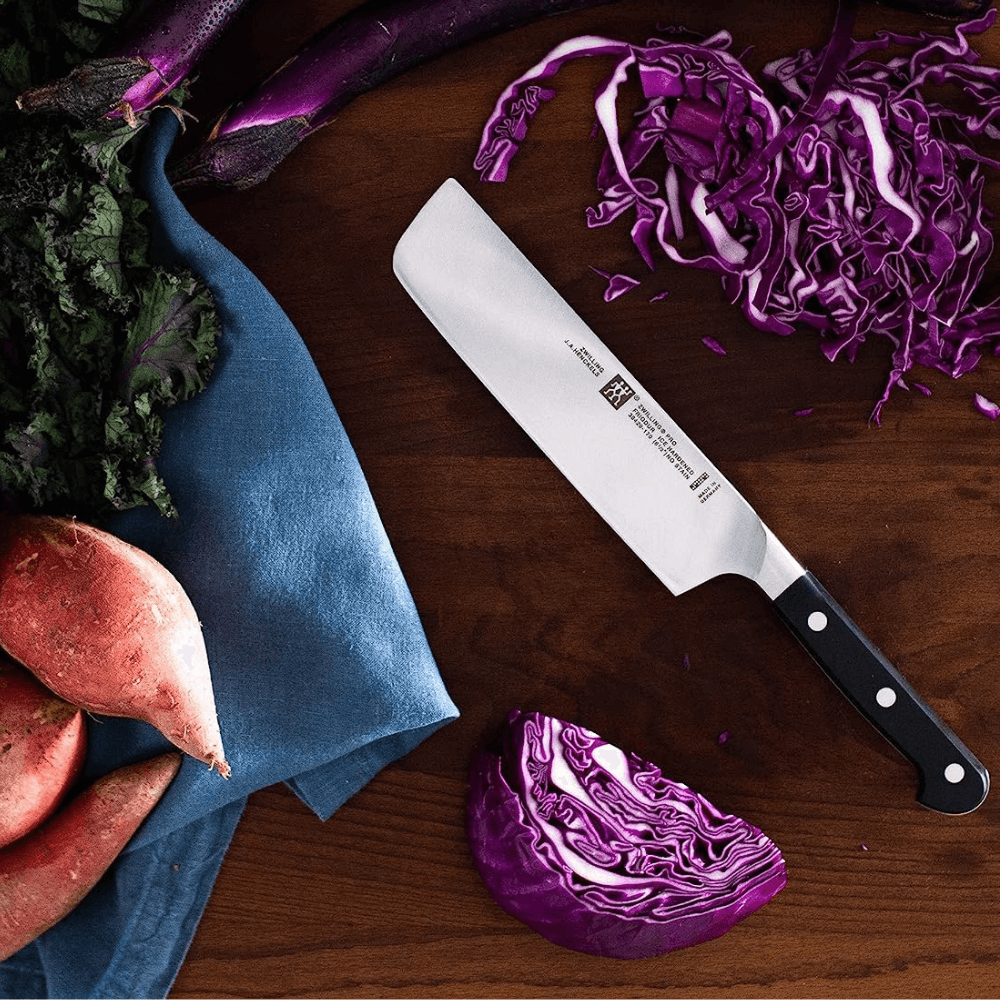Caring for your Nakiri knife is essential for maintaining its longevity and optimal performance. Proper maintenance ensures that your knife remains sharp, durable, and ready for all your vegetable preparation needs.
In this micro-guide, we will guide you through essential maintenance tips, covering everything from cleaning and storage to sharpening and common mistakes to avoid.
Following these guidelines ensures that your Nakiri knife remains a reliable and indispensable tool in your culinary endeavors.
To deepen your knowledge and understanding of the Nakiri knife, it is recommended to explore our article "The Anatomy of a Nakiri Knife: Understanding Its Parts and Function." By understanding the various components of the knife and learning how to properly maintain it, you'll truly appreciate the craftsmanship and functionality of this essential kitchen tool.
Jump To:
The Importance of Knife Care
Cleaning Your Nakiri Knife
Storage and Protection
Sharpening and Honing
Removing Rust and Stains
Avoiding Common Mistakes
Honing and Sharpening Services
Regular Maintenance Routine
Safety Considerations
The Importance of Knife Care
Caring for your Nakiri knife goes beyond mere aesthetics. It plays a vital role in preserving the knife's functionality and lifespan.
Regular maintenance keeps the blade sharp and prevents rust, corrosion, and potential damage. By investing a little time and effort into knife care, you can enjoy the long-term benefits of a well-maintained Nakiri knife.
Cleaning Your Nakiri Knife
Proper cleaning is crucial to remove food particles, oils, and other debris that can compromise the knife's performance and lead to unpleasant odors. After each use, rinse the knife under warm water and use a mild dish soap to gently clean the blade and handle.
Avoid harsh scrubbing pads or abrasive cleaners, as they can scratch the surface of the knife. Finally, thoroughly dry the knife with a clean cloth to prevent moisture buildup and potential rust.
Storage and Protection
Storing your Nakiri knife properly is essential to prevent accidents and maintain its sharpness. Avoid storing it loosely in a drawer or with other utensils, as this can lead to blade damage or injuries.
Instead, consider using a knife block, magnetic strip, or a knife sheath to protect the blade and keep it safely stored. Ensure that the storage area is clean, dry, and away from extreme heat or humidity.
Sharpening and Honing
Keep your Nakiri knife sharp for effortless and precise vegetable preparation. Regular honing helps maintain the knife's edge between sharpening sessions.
Use a honing rod or a ceramic honing tool to realign the edge, gently running the knife along the rod at a consistent angle.
Regarding sharpening, options include sharpening stones, electric sharpeners, or professional services. Follow the manufacturer's instructions or seek professional guidance to ensure proper sharpening techniques.
Removing Rust and Stains
Despite your best efforts, your Nakiri knife may develop rust or stains over time, especially if it is not dried thoroughly or stored improperly.
To remove rust, apply a rust-removing solution or a mixture of baking soda and water to the affected area. Use a soft cloth or sponge to gently scrub the rust away, then rinse and dry the knife.
For stubborn stains, a paste made of baking soda and water can be applied and gently scrubbed before rinsing and drying.
Avoiding Common Mistakes
To maintain your Nakiri knife's quality, avoid common mistakes such as cutting on hard surfaces like glass or marble, using the knife for inappropriate tasks (e.g., bone cutting), leaving it wet or dirty for extended periods, or putting it in the dishwasher.
These practices can damage the blade, handle, and overall knife functionality.
Honing and Sharpening Services
If you're uncertain about honing or sharpening your Nakiri knife yourself, consider seeking professional honing and sharpening services.
Experienced knife sharpeners can restore the blade's sharpness and provide guidance on proper maintenance techniques.
Research reputable service providers in your area or consult with local chefs or culinary experts for recommendations.
Regular Maintenance Routine
To maintain your Nakiri knife's peak performance, establish a regular maintenance routine. This may include cleaning the knife after each use, honing the blade weekly or as needed, and sharpening the knife when the edge becomes dull.
Adhering to a consistent maintenance schedule ensures that your Nakiri knife is always ready to deliver precise cuts and enhance your culinary experience.
Safety Considerations
Safety should be a top priority when caring for your Nakiri knife. Always handle the knife cautiously, using proper grip techniques and avoiding excessive force.
Store the knife in a secure location, out of reach of children and away from the edge of countertops. Use cutting boards with non-slip surfaces to prevent accidents and ensure stability while cutting.
Caring for your Nakiri knife is a vital aspect of maintaining its functionality and longevity. By following the essential maintenance tips outlined in this micro-guide, you can keep your knife sharp, rust-free, and in optimal condition for years to come.
Remember to clean and dry the knife after each use, store it safely, regularly hone and sharpen the blade, and avoid common mistakes that can compromise its quality.
With proper care, your Nakiri knife will continue to be a reliable companion in your culinary adventures, enabling precise vegetable preparation and enhancing your cooking experience.
If you're in the market for a new Nakiri knife or looking to make your first purchase, our article on the top 5 Nakiri knife recommendations is a valuable resource to kickstart your search.



